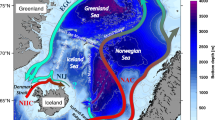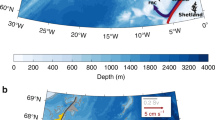Abstract
The overflow and descent of cold dense water from the Denmark Strait sill — a submarine passage between Greenland and Iceland — is a principal means by which the deep ocean is ventilated, and is an important element in the global thermohaline circulation. Previous investigations of its variability — in particular, direct current measurements1,2 in the overflow core since 1986 — have shown surprisingly little evidence of long-term changes in flow speed. Here we report significant changes in the overflow characteristics during the winter of 1996–97, measured using two current-meter moorings and an inverted echo sounder located at different depths in the fastest part of the flow. The overflow warmed to the highest monthly value yet recorded (2.4 °C), and showed a pronounced slowing and thinning at its lower margin. We believe that the extreme warmth of the overflow caused it to run higher on the continental slope off east Greenland, so that the lower current meters and the echo sounder were temporarily outside and deeper than the fast-flowing core; model simulations appear to confirm this interpretation. We suggest that the extreme warmth of the overflow is a lagged response to a warming upstream in the Fram Strait three years earlier (caused by an exceptional amplification of the winter North Atlantic Oscillation). If this is so, overflow characteristics may be predictable.
This is a preview of subscription content, access via your institution
Access options
Subscribe to this journal
Receive 51 print issues and online access
$199.00 per year
only $3.90 per issue
Buy this article
- Purchase on Springer Link
- Instant access to full article PDF
Prices may be subject to local taxes which are calculated during checkout




Similar content being viewed by others
References
Dickson, R. R., Gmitrowicz, E. M. & Watson, A. J. Deep water renewal in the northern North Atlantic. Nature 344, 848–850 (1990).
Dickson, R. R. & Brown, J. The production of North Atlantic Deep Water: sources, rates and pathways. J. Geophys. Res. 99, 12319–12341 (1994).
Jungclaus, J. H. & Backhaus, J. O. Application of a transient, reduced-gravity, plume model to the Denmark Strait Overflow. J. Geophys. Res. 99, 12375–12396 (1994).
Cayan, D. R. Latent and sensible heat flux anomalies over the northern oceans: the connection to monthly atmospheric circulation. J. Clim. 5, 354–369 (1992).
Hurrell, J. W. Decadal trends in the North Atlantic Oscillation: regional temperatures and precipitation. Science 269, 676–679 (1995).
Barnston, A. G. & Livezey, R. E. Classification, seasonality and persistence of low-frequency atmospheric circulation patterns. Mon. Weath. Rev. 115, 1083–1126 (1987).
Hurrell, J. W. & van Loon, H. Decadal variations in climate associated with the North Atlantic Oscillation. Clim. Change 36, 301–326 (1997).
Dickson, R. R. et al. The Arctic Ocean response to the North Atlantic Oscillation. J. Clim.(submitted).
Swift, J. H. & Aagaard, K. Seasonal transitions and water mass formation in the Iceland and Greenland Seas. Deep-Sea Res. 28, 1107–1129 (1981).
Smethie, W. M. & Swift, J. H. The tritium: krypton-85 age of Denmark Strait Overflow Water and Gibbs Fracture Zone Water just south of Denmark Strait. J. Geophys. Res. 94, 8265–8275 (1989).
Swift, J. H. & Koltermann, K. -P. The origin of Norwegian Sea Deep Water. J. Geophys. Res. 93, 3563–3569 (1988).
Aagaard, K., Fahrbach, E., Meincke, J. & Swift, J. H. Saline outflow from the Arctic Ocean: its contribution to the deep waters of the Greenland, Norwegian and Icelandic seas. J. Geophys. Res. 96, 20433–20441 (1991).
Mauritzen, C. Production of dense overflow waters feeding the North Atlantic across the Greenland- Scotland Ridge: Part 1. Evidence for a revised circulation scheme. Deep-Sea Res. 43, 769–806 (1996).
Strass, V. H., Fahrbach, E., Schauer, U. & Sellmann, L. Formation of Denmark Strait Overflow Water by mixing in the East Greenland Current. J. Geophys. Res. 98, 6907–6919 (1993).
Swift, J. H. Dissolved Oxygen in the Arctic Ocean and Nordic Seas. Proc. ACSYS Conf. 2, 259–261 (1997).
Rudels, B., Quadfasel, D. & Friedrich, H. J. The Arctic Circumpolar Boundary Current. Deep-Sea Res.(submitted).
Meincke, J., Rudels, B. & Friedrich, H. J. The Arctic Ocean-Nordic Seas thermohaline system. Int. Council Explor. Sea J. Mar. Sci. 54, 283–299 (1997).
Dickson, R. R., Lazier, J., Meincke, J., Rhines, P. & Swift, J. Long-term coordinated changes in the convective activity of the North Atlantic. Prog. Oceanogr. 38, 241–295 (1996).
Dickson, R. R., Meincke, J., Malmberg, S-A. & Lee, A. J. The “Great Salinity Anomaly” in the Northern North Atlantic, 1968–82. Prog. Oceanogr. 20, 103–151 (1988).
Acknowledgements
This work was funded in part by the EC MAST-III VEINS programme, and in part by the SIO/LDEO Consortium of the NOAA Global Change Program.
Author information
Authors and Affiliations
Corresponding author
Rights and permissions
About this article
Cite this article
Dickson, B., Meincke, J., Vassie, I. et al. Possible predictability in overflow from the Denmark Strait. Nature 397, 243–246 (1999). https://doi.org/10.1038/16680
Received:
Accepted:
Issue Date:
DOI: https://doi.org/10.1038/16680
This article is cited by
-
Climate change effects on Arctic fjord and coastal macrobenthic diversity—observations and predictions
Marine Biodiversity (2011)
-
Observed sources and variability of Nordic seas overflow
Nature Geoscience (2009)
-
Spatial and temporal structure of the Denmark Strait Overflow revealed by acoustic observations
Ocean Dynamics (2007)
-
Decreasing overflow from the Nordic seas into the Atlantic Ocean through the Faroe Bank channel since 1950
Nature (2001)
-
All change in the Arctic
Nature (1999)
Comments
By submitting a comment you agree to abide by our Terms and Community Guidelines. If you find something abusive or that does not comply with our terms or guidelines please flag it as inappropriate.



